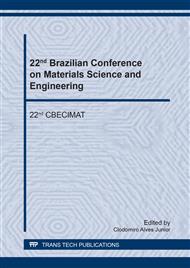p.230
p.236
p.241
p.248
p.254
p.258
p.264
p.270
p.276
Degradation of Colored Polystyrene Films
Abstract:
Polystyrene is commercial polymer of extensive use in industrial scale due to great physical and chemical properties and low cost. Lifespan of polymer materials can be changed by incorporation of additions to polymeric matrix.The present study aimed to evaluate the influence of crystal violet dye in polystyrene matrices when irradiated by visible radiation. The samples were studied in the form of films, in which solution of crystal violet (5.0x10-4mol.L-1) was added to the PS solution (8% w / w). The films were irradiated with commercial lamp for 150 hours and analyzed with UV-Vis and FTIR. The results showed that the dye degraded at a rate of 16%, however the FTIR analysis revealed that polystyrene did not degrade under the conditions studied, since no formation of carbonyl compounds was observed.
Info:
Periodical:
Pages:
254-257
Citation:
Online since:
September 2018
Keywords:
Price:
Сopyright:
© 2018 Trans Tech Publications Ltd. All Rights Reserved
Share:
Citation:


